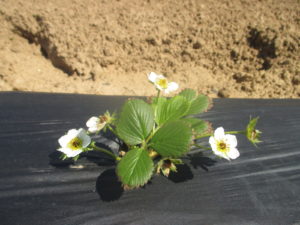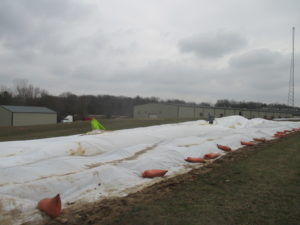Strawberries growing in the matted-row system are in the blooming stage. Open flowers cannot tolerate temperatures lower than 30°F (Figure 1). Strawberry growers should be prepared for the coming low temperatures this week.
Row covers (Figure 2) can be effective in protecting strawberry flowers. In our earlier trial, 1.5 oz/sq row covers provided 4-6 degrees protection and successfully protected strawberry blooms in the earlier frost happened in middle April (the recorded lowest temperature was 24.5°F at Southwest Purdue Agricultural Center). Lighter row covers (0.05-1.0 oz/sq) provided fewer degrees of protection and double layers can be more effective. When using row covers for frost protection, be sure to have good soil moisture, sometimes running water through the drip line may add heat in the system. Apply row covers in the early afternoon to attract more heat before temperature drops. Although row covers can be effective in protecting strawberry blossom from frost damage, the drawback is they have to be pulled back during the day following a night of cold protection, as flowers need to be pollinated either by wind or insects.
Sprinkler irrigation is another option. It might be cheaper, less labor-intensive, and cover a larger area. When atmospheric condition is dry, start sprinkling when blossom temperature reaches 32 to 33°F. Keep running water past the sunrise, do not stop before the blossom temperature is registering 32°F. When using sprinkler irrigation for frost protection, it is critical to accurately measure blossom temperatures to guide the decision of when to start and shut off irrigation. Atmospheric temperatures may not always reflect actual blossom temperatures. Dr. Barclay Poling at NCSU recommended using a digital thermometer to measure blossom temperatures. Here is a video of Dr. Poling showing how to use the digital thermometer.

